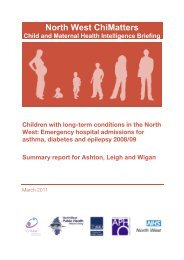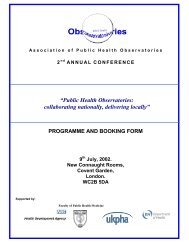9261 HEPATITIS C REPORT GALLEY - North West Public Health ...
9261 HEPATITIS C REPORT GALLEY - North West Public Health ...
9261 HEPATITIS C REPORT GALLEY - North West Public Health ...
You also want an ePaper? Increase the reach of your titles
YUMPU automatically turns print PDFs into web optimized ePapers that Google loves.
2. establish the extent of co-infection of hepatitis C and hepatitis B<br />
3. elucidate risk factors for hepatitis C infection<br />
4. explore the effect of knowledge of previous hepatitis test results on behaviour<br />
5. identify factors that predict sharing of equipment<br />
6. establish a cohort for follow up and establish feasibility of monitoring hepatitis C<br />
infection among drug using populations using saliva samples (results not covered<br />
in this report).<br />
Key Findings and Recommendations<br />
This study has identified the following key findings and recommendations:<br />
• Among the 341 injecting drug users in this study, the prevalence of hepatitis C<br />
was 53.1% (181 people), hepatitis B 26.6% (89 people) and 19.0% (65 people)<br />
were co-infected with hepatitis C and B (Section 4.1). Although the study was<br />
relatively small, different areas of study recruitment provided different levels of<br />
hepatitis C infection, with those presenting to drugs services requesting a test or<br />
those in treatment with community drugs teams having the highest prevalence.<br />
Those who had been for a hepatitis C test before this study were 1.68 times more<br />
likely to be hepatitis C positive in this study, again suggesting that people<br />
presenting for tests are more likely to be hepatitis C positive (Section 4.4).<br />
Models of health impact of hepatitis C should consider potential variations in<br />
prevalence rates between settings and recognise that most studies to date have<br />
assessed those most at risk of infection.<br />
• We crudely estimate that there are around 30,200 drug users currently in contact<br />
with services in the <strong>North</strong> <strong>West</strong>. Using estimates of the proportion of these injecting<br />
drugs, and applying the hepatitis C prevalence of 53% found in this study, we<br />
estimate that there are 12,800 people currently chronically infected with hepatitis C.<br />
Of these, 2,600 will go on to develop serious liver damage (cirrhosis or hepatic<br />
carcinoma) (Section 5.1). This figure does not include the hidden population of drug<br />
users, previous or new users entering the drug-using population.<br />
<strong>Health</strong> Authorities should anticipate the increase in treatment costs associated with<br />
treating this high number of patients with liver damage over the next twenty years.<br />
H EPATITIS C IN INJECTING DRUG USERS IN THE N ORTH W EST<br />
3











